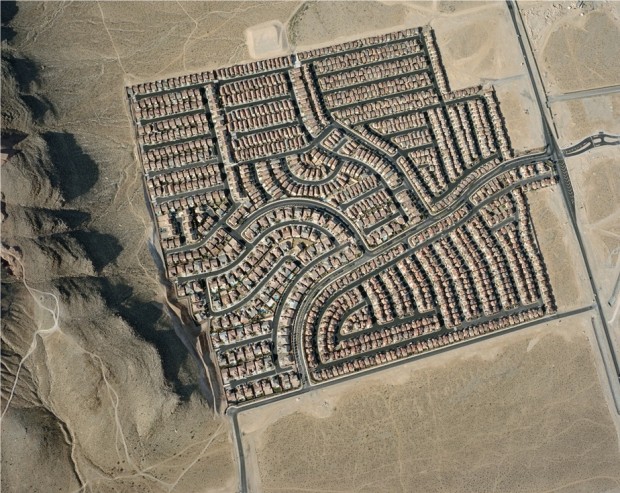An iconographic and text archive related to communication, technology and art.
☛ Christoph Gielen: Untitled V, 2010, Nevada (©).
Christoph Gielen’s work offers a great opportunity to take a couple of steps back and think about the way we transform the environment around us in order to make it more hospitable. In return, those transformations do have a significant impact upon us: a suburb like the one shown above must indeed shape the way one live within it. Sure, those photographs depicts communities: groups of people living in the same space. However, what strikes the viewer is the way some of those community appears to be completely isolated:
The Sun Belt suburbs depicted in these photographs are “absolutely self-contained,” Gielen suggests; many of them, he adds, are “not changing anymore.” They are static, crystalline and inorganic. Indeed, some of these streets frame retirement communities: places to move to once you’ve already been what you’ve set out to be. This isn’t sprawl, properly speaking. They are locations in their own right, spatial endpoints of certain journeys. (The New York Times: “The Geometry of Sprawl” by Christoph Gielen and Geoff Manaugh, September 17, 2010)
Those ideas resonate surprisingly well with Peter Sloterdijk’s extensive work on the concept of space:
Today we are again foregrounding the way a building can isolate, although this should not be confused with its massiveness. Seen as an independent phenomenon, isolation is one form of explication of the condition of living with neighbours. Someone should write a book in praise of isolation, describing a dimension of human coexistence that recognizes that people also have an infinite need for non communication. Modernity’s dictatorial traits all stem from an excessively communicative anthropology : for all too long the dogmatic notion of an excessively communicative image of man was naively adopted. By means of the image of foam you can show that the small forms protect us against fusion with the mass and the corresponding hyper-sociologies. In this sense, foam theory is a polycosmology. (“Spheres Theory: Talking to Myself about the Poetics of Space” by Peter Sloterdijk, Harvard University Graduate School of Design, February 17, 2009)
Below are more resources both about Christoph Giele and Peter Sloterdijk:
- To my knowledge, the most in-depth survey of Peter Sloterdijk’s work already translated into English and available online can be found over at Sean Sturm’s blog. See “Peter Sloterdijk in English”.
- Compare Christoph Giele’s photographs with Ross Racine digital drawings of fictional suburbia.
- Check out the exhibition “Engineering the Landscape” hosted by the Forward Thinking Museum (New York, New York, NY, November 2010).
- Christoph Gielen wrote or collaborated to four essays published in the New York Times.
- There are two entries about Christoph Gielen over at the BLDG BLOG.
- You can read a review of Christoph Gielen’s exhibition “Arcadia” (hosted at the Daniel Cooney Fine Art gallery in early 2009) over at DLK Collection.
- By Philippe Theophanidis
- on
- ― Published in Art, Communication, Photography
- Tagged: architecture, building, city, community, construction, environment, Giele, home, house, landscape, map, Sloterdijk, space, suburb

